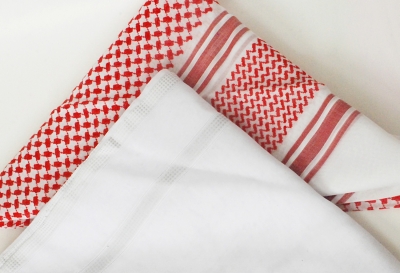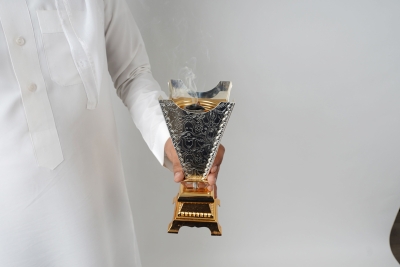



Traditional Female Garments in the Kingdom of Saudi Arabia refer to the garments that emerged as a result of customs and traditions in Saudi women's dress. Over time, it has evolved and diversified with cultural shifts according to women's preferences for local and global fashion. Traditional garments are considered a national heritage identity closely tied to the customs of each province in Saudi Arabia.
Al-Abaya in traditional female garments in Saudi Arabia
Al-Abaya is a garment that women in Saudi Arabia adhere to and prioritize in all social settings, especially when leaving the house. However, it is not legally mandatory, as women can go out wearing any modest garment. Abaya is often worn with other pieces of clothing, such as the hijab, al-Shilah, al-Niqab, or al-Burqa.
In general, women in Saudi Arabia wear Abaya to cover their entire body and maintain modesty. There are different types, including the standard Abaya, the shoulder Abaya with or without embellishments, and the head Abaya, which is looser.
In the past, women wore specific types of clothing based on their region and traditions, and some of these traditional garments are still worn today during social occasions, holidays, and visits. These traditional women's outfits remain an essential aspect of the cultural heritage preserved by each region.
Saudi women's hijab
There are various types of hijab in Saudi female garments. One of them is al-Niqab, a black covering placed over the face with an opening for the eyes. Al-Burqa is similar to al-Niqab but features a fabric divider between the eyes. It is a traditional garment locally, often worn by older women in Saudi society.
Another type is al-Shilah or at-Tarhah, a black fabric wrapped around the face, covering the head, usually worn with al-Niqab or al-Burqa.
Some women prefer to cover their faces using al-Litham, wrapping al-Shilah around the mouth and nose along with the head. All these coverings are widely used across different regions of Saudi Arabia, with variations in how they are worn based on the customs and traditions of each region.
Traditional female garments in western Saudi Arabia
Al-Masdah, well-known in western regions of Saudi Arabia, is a traditional outfit with rectangular sleeves, designed as a wide transparent dress sewn from a fabric divided into five pieces of different sizes.
In Makkah al-Mukarramah Province, some women's clothes were made from al-Dot fabric embroidered with several colors and embellished with silk and gold thread (qasab). They also used the al-Qarkosh fabric, which is red and decorated with black at the edges and center.
Al-Kurta is recognized as a traditional women's garment in al-Madinah al-Munawwarah Province. It is a dress gathered at the waist, varying in color and fabric. The color of this dress used to be determined by the wearer's age, with older women typically wearing lighter colors, while younger women wore al-Kurta made of silk in bright colors. At home, women wear cotton as-Sidiriyah (vest) along with al-Mehrama, which is made from cotton fabric to cover their hair. Al-Mehramah comes in two types: a plain one and another that is hand-decorated at the edges and worn for weddings and special occasions.
A bride in al-Madinah al-Munawwarah Province would wear a traditional outfit known as al-Shara'a al-Madini, a pink dress embellished with golden threads with a part to cover the head. It comes in several designs.
Traditional female garments in central Saudi Arabia
In Riyadh and Qassim Provinces, some women used to wear a garment known as Mneikhel , a loose-fitting dress with wide sleeves. It is distinguished by how it is worn as the woman flips the sleeves over her head. Another garment commonly worn was al-Meshallal dress, which is wide, lightweight, and decorated, typically worn over a regular dress. It comes in two colors: dark red and black.
Al-Darra'ah is also worn by women in the central and northern regions of Saudi Arabia. Al-Darra'ah has several types, such as the Indian al-Darra'ah, imported from India, and Darra'at Umm Wardah, named for its rose-shaped embroidery, Darra'at al-Zari, Darra'at Kate, Darra'at Kinawi, Darra'at Qirmiz, and Darra'at Umm Tift.
Traditional women's garment in eastern Saudi Arabia
Women's garments in the Eastern Province of Saudi Arabia vary, with some outfits worn daily and others reserved for special occasions. One notable garment is al-Nafnouf, which has an Indian-style design and is made of silk and satin. Al-Darra'ah is also commonly worn. It is a loose, long dress that is the traditional garment for women in the province. Its fabric and design vary depending on the occasion, with lighter, easy-to-move fabrics for daily wear and heavier, embroidered, and decorated versions for special occasions.
On the other hand, al-Hashemi dress in the Eastern Province is characterized by its width and the length of its sleeves. It is worn for decorative purposes over ordinary clothing and is embroidered with various patterns using gold threads and silk, coming in several colors. Al-Shalhah is also an everyday garment for women in the Eastern Province, as its length reaches the knee and its sleeves are long but not wide. Another daily garment is al-Shaylah, featuring silk and gold embroidery on its edges and previously known as al-Milfa'a. For special occasions, there are several other traditional garments, including al-Masrah dress, al-Manthoor dress, and al-Thuraya dress.
Additionally, the Eastern Province has various types of Abayas worn by women, such as al-Anajer Abaya, decorated with golden threads; al-Shemla, made of wool; al-Buroji, with red threads; al-Hasawiyah abaya; al-Haykiyah Abaya; Faysoul Abaya, made from soft black wool; al-Habara Abaya; and al-Deffah Abaya.
Traditional female garments in northern Saudi Arabia
Several garments are popular in Hail, al-Jawf, and the Northern Borders Provinces, including al-Murowdin dress, which covers the entire body with triangular-shaped sleeves that reach the ground, and al-Mujowthal, a long, loose garment made of cotton and silk that is longer than the woman wearing it by half m or more.
Additionally, the dress adorned with engravings and draws is considered one of the traditional women's outfits in Tabuk Province, northwest of Saudi Arabia. It is a long dress that covers the entire body with long sleeves. The dress is accompanied by al-Sidiriyah, which is worn on the upper part of the body, has an open front, and features golden buttons. The trousers are made of cotton fabric in various colors.
Traditional female garments in southern Saudi Arabia
The Aseeri dress, formerly known as al-Muzannad, is one of the traditional garments in Aseer Province, southwest of Saudi Arabia. It is made of black silk and embellished with gold and silver threads. This garment remains popular in Aseer, with new designs and styles emerging while preserving this traditional dress's original identity.
In the past, women in al-Bahah Province were famous for wearing a traditional garment called al-Mushal dress. The term "al-Mushal" refers to something kept until needed, which is why women only wore this dress for celebrations, weddings, and holidays. Additionally, during that time, women's clothing was primarily black.
A well-known traditional garment from Najran Province is al-Mukammam, a long, loose black dress with wide sleeves embellished around the waist and chest. It was accompanied by a white long-sleeved dress underneath. The hand-embroidered al-Kurta garment was a popular women's garment in Jazan Province. It was typically worn with long striped trousers underneath.
Related quizzes
Related articles

